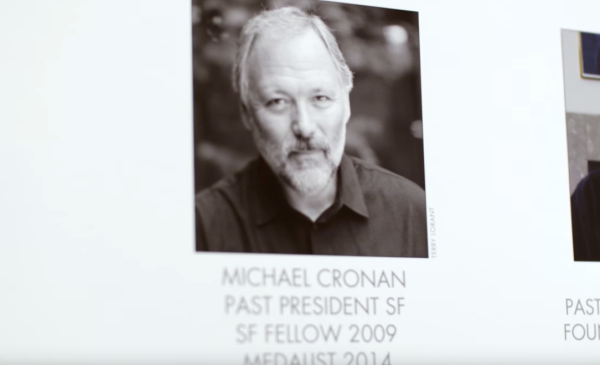
Recognition
2014 AIGA Medal
Born
1951, San Francisco, California
Deceased
2013, Berkeley, California
By Michael Vanderbyl
September 15, 2014
Recognized for crafting iconic names, identities and branding strategies that have become an essential part of the American vernacular and for his generosity of spirit.
Michael Patrick Cronan was a big man with a big heart—attributes equaled by his stature as a designer. Like the man himself, Cronan’s work was eloquent, intelligent and deeply human, and his naming of Kindle and TiVo (both the company and their core product), and the identities he created for Amazon Kindle and TiVo, have become an essential part of the American vernacular. As a brand consultant, a role he often played in the latter part of his career, Cronan was persuasive and astute. He had a way with words. But he also possessed an uncanny ability to point clients in the right direction—and their loyalty never wavered.
Born in San Francisco in 1951, Cronan grew up in nearby Sacramento, where his discovery of letterpress in a junior high class eventually led to a job creating posters at a local print shop. He received a degree in fine art at California State University, Sacramento, and studied at what is now California College of the Arts (CCA). Cronan first came to national prominence in the 1980s along with a group of fellow San Francisco–based designers nicknamed “The Michaels” (Cronan, Mabry, Manwaring and me), whose “sprightly and colorful” graphics, as described by design historian Steven Heller, came to be known as the Pacific Wave.

NATO Fifty-Year Anniversary stamp, 1999 Client: U.S. Postal Service; Design firm: Cronan Design; Designer and illustrator: Michael Cronan.

Yes poster, 2000 Client: Michael Cronan; Design firm: ::CRONAN::; Designer and illustrator: Michael Cronan; Creative director: Karin Hibma.

Amazon Kindle wordmark, 2006 Client: Amazon; Design firm: ::CRONAN::; Designers and name creators: Michael Cronan, Karin Hibma.
Establishing Michael Patrick Cronan Design with business partner and wife Karin Hibma in 1980, Cronan’s clients over the years have included Apple, Estée Lauder Origins, Levi Strauss & Co., SFMOMA, the U.S. Postal Service and Williams-Sonoma. In 1992 he and Hibma created a line of apparel called Walking Man. (In Design Observer, Michael Bierut wrote that, “Like the designer, the garments were big, warm and comforting.”) The line received I.D. Magazine’s 1992 Consumer Product Gold Award. It is a testament to their longstanding partnership that Cronan and Hibma were recognized jointly on Fast Company’s list of the “100 Most Creative People in Business” in 2009.
Anyone who met Cronan was immediately charmed by his humor and warmth and awed by his limitless energy. Colleagues found his work inspiring and instructive. Clients felt lucky to have him as their ally. He was not only a brilliant designer but also an awe-inspiring human being.
Cronan, recognized for uncommon artistry throughout a nearly 40-year career, had work featured in the 1987 Museo Fortuny exhibition “Pacific Wave, California Graphic Design,” as well as SFMOMA’s very first design exhibition, “In the Public Eye,”in 1993. His work also resides in the permanent collections of the Denver Art Museum, the Library of Congress, SFMOMA, the Smithsonian Institution and the Victoria and Albert Museum in London. Cronan was deeply involved in San Francisco’s design community. He was a founding member and president of AIGA San Francisco, served on the AIGA board from 1991 to 1994 and was named an AIGA Fellow. He taught at CCA for nearly two decades in the 1980s and ’90s.
Widely admired for his virtuosity as a designer and the indelible mark he left on the world of design, Cronan was also known for the peerless example he set as a husband and father. He and Hibma not only worked side by side throughout his career, but raised two sons, Shawn HibmaCronan, a sculptor, and Nick Cronan, an industrial designer, who both carry forward their father’s creative legacy. Later in his life, Cronan even became known for large-scale portrait paintings—his outsize talent always overran boundaries.
Cronan passed away in Berkeley on January 1, 2013, after five years of living with cancer.
Keep in Touch with AIGA
Sign up for email communications to be the first for updates on webinars, events, programs, and announcements.